CyberSyn - An Ambitious Project of Socialist Economics
50 years after CyberSyn - Wait, what is CyberSyn?
This year, 2021, marks the 50th birthday of project CyberSyn. It was started in 1971 in Chile with the purpose of organizing the economy in a decentralized fashion. CyberSyn is rarely talked about and sometimes misportrayed as a system of centrally controlled economy. Looking closer at it, it was all about decentralization and can be a source of inspiration for decentralized anarchist economies. It has very interesting and revolutionary concepts and was extremely scientifically advanced for its time. As CyberSyn is based on the ideas of Cybernetics, this article first looks at Cybernetics (another rarely talked about topic) and then comes back to CyberSyn.
Hold on for this ride back in history that still feels like science fiction.
What is Cybernetics
Today, we have a lot of words starting with "Cyber" that have their origin in Cybernetics: Cyberspace, Cyberpunk, Cybercrime, Cybersecurity, Cyberwarfare, Cybersex, Cyberbullying, Cyborg, Kubernetes. Cybernetics was founded as a science in the 1940s but lost its relevance about 40 years later. What happened to it and was this all about?
Definition
Cybernetics is the science of communication and control of complex systems in changing environments. The etymologic roots of the word come from the greek κυβερνήτης which means steersman or governor (not in the sense of ruling over others, but in the sense of self-organizing). Imagine a sailor wanting to sail from A to B. She cannot influence the complex and changing environments of winds and currents, but she can still steer the ship in a direction, evaluate the effects of her actions and correct the course, again and again, adapting to the changing environment. Cybernetics is about understanding complex systems and finding ways to abstract from the complexity with the help of self-regulating systems.
The ideas of cybernetics are used in many fields like engineering, biology, psychology, and system theory. Cybernetics influenced many of today's sciences, including reinforcement learning, machine learning, and computer science as a whole.
History
In the 1940s a group of scientists from various fields came together in a transdisciplinary effort to understand self-regulation and feedback loops in biology and engineering. They tried to find common patterns across their fields of research and thus develop a better understanding. Alan Turing and John von Neumann were some of the well-known participants.
Norbert Wiener gave this transdisciplinary research the name Cybernetics in 1947. The birth of Cybernetics can be seen as the big bang of the information age. You can get a feeling of the excitement of that time when reading about the Homeostat. The only purpose of this machine was to show that it can stay in a steady state even if the environment is changing. The machine was compared to a brain.
The Soviet Union was first skeptical of Cybernetics and deemed it "pseudoscience". However, after Stalin died in 1953, they increased their efforts in Cybernetic research. They started calling everything which involved computers Cybernetics. In consequence, the CIA founded a special unit monitoring the cybernetic ambitions of the Soviet Union. The CIA was under the false assumption that the Soviet Union already had a huge network of computers and cybernetic tools. Also due to these Cold War scares, the word Cybernetics was avoided in the US and Cybernetics split up again in isolated Sciences like Artificial Intelligence (founded in 1956).
While Norbert Wiener was a pacifist, the idea of Cybernetics was used for power fantasies on both sides of the Cold War.
In 1959 Stafford Beer started to apply the ideas of Cybernetics to organizations. He was a consultant for companies and helped them find issues in their organizations and restructure them for more efficiency. See the next section for more information on his work.
In the 1980s Cybernetics lost its cultural relevance. It was mostly replaced by "Informatics". Today, only very few universities use the term Cybernetics in their curriculum.
Organizational Cybernetics
It was shown that biological as well as mechanical systems can cope with complex environments by using cybernetic principles like communication and feedback. Stafford Beer applied these ideas to the complex systems of organizations and interactions between units of organizations. He even thought of societies as cybernetic systems.
Beer explains why only decentralized organizations can cope with complex environments: Applying the laws of cybernetics, he concludes that the complexity inherent in organizations or societies needs to be dealt with in some way or another. The top-down way is to attenuate the complexity very radically, losing a lot of information, so that a central leader can process the remaining information and make decisions based on that. This leads to a lot of domination, instability, and chaos for the entities of the system. The cybernetic way of dealing with complexity, and this is the one that Beer proposed, is to decentralize as much as possible. That way the complexity is absorbed by or encoded in the units of the system which can then self-regulate as best as possible. Only relevant information will be shared with other units in a way that everyone can still have an overview of the system as a whole and give feedback when needed.
Inspired by cybernetic principles in the human nervous system, Beer developed a model called Viable System Model (VSM) which he used to analyze organizations. The VSM is not meant as a blueprint for restructuring organizations but more as a tool that can help to find organizational issues.
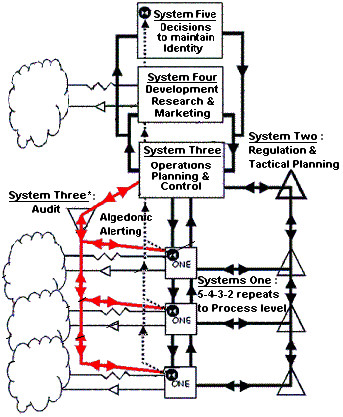
At the lowest level of a VSM are units called "System One". Each unit has a specific task and is self-regulating. System Ones operate by looking at information from the environment that is relevant for their task, doing their thing and influencing the environment in their way, always adapting to changed information from the environment. A System One unit in itself can be considered a VSM at another level. I.E. the VSM is a recursive concept that can be applied to various levels of detail, e.g. at the level of a branch of industry, at the level of a company, or the level of a team within that company. A System One unit is autonomous as long as it works within the constraints set by the needs of the whole system.
System Two is responsible for the communication between System One units. It ensures that System Ones don't have conflicting goals and thus don't create overshooting or oscillating effects in the environment by trying to counter-act on what the other unit was doing.
System Three defines the decision space in which systems one and two can operate autonomously. It is responsible for giving feedback to systems one and two if they are operating outside of the expected space. It also serves as an interface to systems four and five, by providing them with all the important information from systems one and two.
System Four is responsible for keeping an overview of the environment and the operations of systems one to three. Based on that information, it is developing a strategy for the VSM and communicates that to system three.
System Five can be seen as the brain in the nervous system. It is responsible for long-term strategic thinking and the vision and purpose of the whole VSM.
Beer did not think of System Three, Four, and Five as managers who are imposing their will on the workers in the lower ranks, but rather as a requirement or role in a viable organization that has to be fulfilled. The roles of Systems 3-5 could be fulfilled by a group of people, as a rotating task, or in any other way.
According to Beer, societies are too complex to be managed by governments. The only way governments can do so, is by radically reducing the complexity (e.g. by using guns or other punishments) and thus the will of the people. He sees the cause of instabilities in societies in the failure to use decentralized organizational measures.
Some other terms from Organizational Cybernetics:
- Variety: The number of possible states in a system. It is a measure of complexity.
- Requisite Variety: Enough variety to be able to act autonomously but not too much to become non-manageable. The law of requisite variety says that for a system to get into a non-chaotic state, the information it receives from the environment has to be reduced (attenuator) and the way it interacts with the environment has to be increased (amplifier). The variety of a System One has to be lower than the environment in which it operates. However, its variety can't be too low, as it won't be able to absorb the environment's complexity otherwise.
- Algedonic Feedback/Alerts: Very basic feedback on a scale of good to bad.
- Algedonic Meter: A tool called CyberFolk for getting real-time algedonic feedback from the people e.g. during a presidential speech.
CyberSyn
In 1970 Salvador Allende became president of Chile and was the first democratically elected socialist leader in the Americas. Core industries were nationalized. Chilenians got very excited and in that revolutionary spirit, they started forming worker's councils and taking over factories from huge corporations on their own. These fast changes to the economy lead to economic problems and the government was looking for solutions.
One of the employees of the government, Fernando Flores, had read about Cybernetics and especially Stafford Beer's Organizational Cybernetics and suggested getting some consulting. So he wrote a letter to Beer asking if one of his employees could come to Chile and advise them. Stafford Beer was instantly captivated by the chance of analyzing a whole economy with cybernetic means and came to Chile in 1971.
Allende was a Marxist but not in favor of the Soviet-Union-style top-down command and control. Thus, the ideas of decentral self-regulation of Cybernetics were very appealing to him. When Beer presented his ideas to him and explained System Five, Allende said "this is the people - not the president".
Beer gave some workshops during the day and continued to adapt his ideas during the night. He stayed for months and helped to develop the project CyberSyn. CyberSyn is short for Cybernetics and Synthesis. CyberSyn consisted of four main components that will be explained in the following.
CyberNet
The core components of cybernetic systems are communication and feedback. As this is just 2 years after the ARPANET, there is no such thing as the Internet at the time. Also, Chile did not have enough computers to create a network. Luckily, someone on the team found some unused Telex-machines so they built a network of those. Telex-machines are predecessors of fax machines that were connected to the telephone network but could only send text messages.
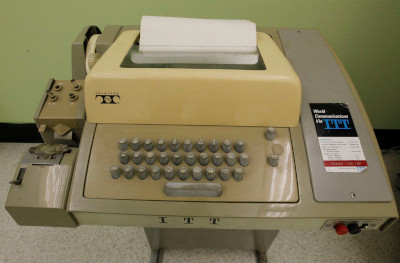
Up to 500 Telex-machines were distributed to the core nationalized factories and connected to the telephone network. Employees of those factories used the machines to send up to 10 key process indicators (KPI) of the factory (e.g. available resources, produced goods, work hours) to the CyberSyn coordination center in Santiago. Each factory could pick its own KPIs. The received numbers were then manually entered in an IBM 360/50 mainframe - the only computer they had available. Some factory workers even went by horse to the next Telex-station to send their numbers to Santiago. This way CyberSyn could make use of "almost real-time" numbers as a basis for their cybernetic processes, which was revolutionary at that time when most of the economic decisions were based on statistics from previous years.
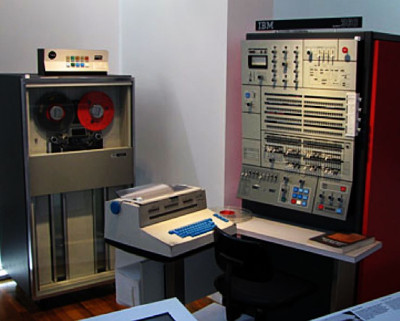
Beer would have preferred decentralized data analysis. However, as they only had one computer, this was not an option.
CyberStride
CyberStride was the software suite developed by the teams around Stafford Beer that was running on the mainframe computer. One component of it was CyberFilter, a set of statistical tools for time series analysis. They used this to analyze the data sent via CyberNet from the factories and would check it for deviations. In case of alarming deviations, they would send feedback via the Telex machine back to the company, fulfilling the role of System Three in the VSM (algedonic feedback).
They used Bayesian Statistics for short-time forecasting of the key economic indicators.
CyberStride was used to gain inside into the economy and as a basis of decisions. The feedback loop was also quite important when coordinating the production and distribution of scarce products.
CHECO
CHECO is short for CHilean ECOnoic simulator. This was another piece of software build with the DYNAMO compiler. (The DYNAMO compiler was famous during that time because of the Limits to Growth model.)
As CyberStride could only do short-time forecasting, the purpose of CHECO was to create a simulation of the entire Chilean economy that would allow long-term forecasting based on various scenarios. The idea was to see the effect of economic decisions in the simulation, testing multiple alternatives, without having to experiment with the real economy.
This project was hardly put into practice during the three years of CyberSyn. However, the idea of using simulations as a basis of economic decisions is still popular today (see e.g. The AI Economist).
OpsRoom
The idea of the OpsRoom was to have a place in which all the relevant information is presented in a consumable way, to be able to discuss it in a group, and to make decisions based on the information. In Stafford Beer's vision, every VSM should have something like this, so he envisioned OpsRooms in factories, OpsRooms for industry branches, and for the whole economy.
They designed the OpsRoom with very state-of-the-art design concepts and also considering ergonomics. Due to the restricted timeline and resources, only one OpsRoom was built, located in Santiago. It allowed to present information on slides (no monitors yet) but it did not have any means to send feedback or control the economy from that room.
However, the media presented the OpsRoom as an elitist central of control. In retrospect, people involved in CyberSyn said they could have seen that coming and maybe building such a room was a mistake.
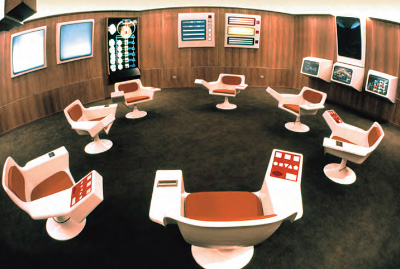
This was designed about 5 years after the original Star Trek series was released. :D
How Project CyberSyn was Ended
In October 1972 a CIA-backed trucker strike took place in Chile. Chile is a very longish country and transport is essential. However, as not all truckers took part in the strike, the CyberSyn team was able to collect all relevant information about available trucks, truckers, and the most important goods in need of transportation via the CyberNet. They managed to coordinate the remaining resources and send the relevant information back via the Telex machines so that the essential goods could still reach their destination. Thus, CyberSyn helped to break that strike.
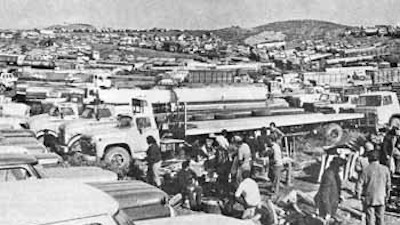
One year later, on September 11th, 1973, a CIA-backed military coup helped Augusto Pinochet to seize power, overthrow the democratically elected government, and install a brutal regime. Allende gave his last speech while gunfire and explosions were approaching the presidential palace and then killed himself.

The people involved in CyberSyn knew there was a chance that their system could become dangerous if it got into the hands of a dictatorship. That's why they destroyed many notes before they left their offices on that day. The OpsRoom, the misportrayed symbol of control, was destroyed by the putschists.
Learnings
Even though this is a very sad ending, there is still a lot to learn from project CyberSyn. A group of very enthusiastic people was able to implement all of this in less than three years. If you look at some of the resources mentioned below, you get the vibes of their enthusiasm. Compared to the impact and success of this project, it is surprisingly almost never mentioned.
The Viable System Model can still be a valuable tool to debug organizations. It allows checking if there are missing channels of communication, if some units deal with too much complexity, or if there is a lack of information or purpose in some units. Using this model, Stafford Beer describes the disadvantages of top-down organizations in complex environments and thus makes the case for decentralized anarchist societies.
Looking at the technical tools of CybeSyn 50 years after they were developed, some are of course outdated, but others are still a valid starting point when thinking about anarchist economies with decentralized real-time planning.
As in CyberSyn, decentralized anarchist planning also needs
- nested or networked entities
- decisions made on the lowest possible level in the nesting hierarchy
- networked communication channels
- information of input and output of entities
- escalation of information to higher levels of nesting if some thresholds are out of bounds
- short time forecasting of production and consumption as input for decision making
- simulations of multiple future scenarios as an additional input for decision making
Let's get inspired by CyberSyn and continue experimenting with tools that can explain and support anarchist economies.
More concrete ideas about anarchist societies and transformation can be found in this text: Planetare Kooperation (German)
Presentation
A short presentation about the origins of Cybernetics and CyberSyn. Feel free to use it.
Sources
- Podcast about CyberSyn
- A short article about CyberSyn
- Detailed Article about anarchist cybernetics, that explains Beer's organizational Cybernetics and how anarchist societies could make use of the VSM.
- Video of a workshop on Organizational Cybernetics with Stafford Beer, in which he also talks about his experience in Chile
- Beer's reflection on CyberSyn
- A short video about CyberSyn and why the OpsRoom doomed the project